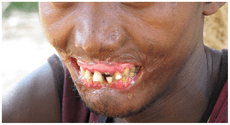Noma (disease)
| Noma | |
|---|---|
 A man afflicted with noma | |
| Classification and external resources | |
| ICD-9 | 528.1 |
| MedlinePlus | 001342 |
| MeSH | D009625 |
Noma (also referred to as cancrum oris, fusospirochetal gangrene, necrotizing ulcerative stomatitis, stomatitis gangrenosa)[1] is a rapidly progressive, polymicrobial, often gangrenous infection of the mouth or genitals.
Causes
Fusobacterium necrophorum and Prevotella intermedia are thought to be key players in the process and interact with one or more other bacterial organisms (such as Borrelia vincentii, Porphyromonas gingivalis, Tannerella forsythia, Treponema denticola, Staphylococcus aureus, and nonhemolytic Streptococcus spp).[2]
The reported predisposing factors include:[3][4]
- malnutrition (particularly A-and B-vitamins) or dehydration
- poor hygiene, particularly oral
- unsafe drinking water
- proximity to unkempt livestock
- recent illness
- an immunodeficiency disease, including AIDS
Presentation
The mucous membranes of the mouth develop ulcers, and rapid, painless tissue degeneration ensues, which can degrade tissues of the bones in the face.[5]
In a condition sometimes called noma pudendi, noma can also cause tissue damage to the genitals.
Prognosis
The disease is associated with high morbidity and mortality[6] and mainly affects children under the age of twelve in the poorest countries of Africa. Children in Asia and some countries of South America are also affected. Most children who get the disease are between the ages of two and six years old.[7] The WHO estimates that 500,000 people are affected, and that 140,000 new cases are reported each year.[8] The mortality rate is approximately 90 percent.[1]
Treatment
Known in antiquity to such physicians as Hippocrates and Galen, noma was once reported around the world, including Europe and the United States. With improvements in hygiene and nutrition, noma has disappeared from industrialized countries since the 20th century, except during World War II when it was endemic to Auschwitz and Belsen concentration camps.[9] The disease and treatments were studied by Berthold Epstein, a Czech physician and forced-labor prisoner who had recommended the study under Josef Mengele's direction.[9]
The progression of the disease can be halted with the use of antibiotics and improved nutrition; however, its physical effects are permanent and may require reconstructive plastic surgery to repair. Reconstruction is usually very challenging and should be delayed until full recovery (usually about one year following initial intervention). [10]
Children and other noma survivors in Africa are helped by a few international charitable organizations, such as Facing Africa, a UK registered charity that helps Ethiopian sufferers. There is one dedicated noma hospital in Nigeria, the Noma Children Hospital Sokoto, staffed by resident and visiting medical teams. In other countries, such as Ethiopia, international charities work in collaboration with the local health care system to provide complex reconstructive surgery which can give back facial functions such as eating, speaking and smiling. Teams of volunteer medics coming from abroad are often needed to support the local capacity to address the most severe cases, which can be extremely challenging even for senior maxillofacial surgeons.[11] On 10 June 2010 the work of such volunteer surgeons was featured in a UK BBC Two documentary presented by Ben Fogle, Make Me a New Face: Hope for Africa's Hidden Children.[12][13]
References
- ↑ 1.0 1.1 Marck, KW (2003). "A history of noma, the "Face of Poverty" (abstract)". Plast Reconstr Surg 111 (5): 1702–7. doi:10.1097/01.PRS.0000055445.84307.3C. PMID 12655218.
- ↑ Neville, Brad. Oral and Maxillofacial Pathology (3rd ed.). Saunders Book Company. pp. 062008. 5.11.
- ↑ Enwonwu CO (2006). "Noma--the ulcer of extreme poverty". N. Engl. J. Med. 354 (3): 221–4. doi:10.1056/NEJMp058193. PMID 16421362.
- ↑ Enwonwu CO, Falkler WA, Phillips RS (2006). "Noma (cancrum oris)". Lancet 368 (9530): 147–56. doi:10.1016/S0140-6736(06)69004-1. PMID 16829299.
- ↑ "AllRefer Health - Noma (Cancrum Oris, Gangrenous Stomatitis)". Retrieved 2007-07-12.
- ↑ Barmes DE, Enwonwu CO, Leclercq MH, Bourgeois D, Falkler WA (1997). "The need for action against oro-facial gangrene (noma)". Trop Med Int Health 2: 1111–1114. doi:10.1046/j.1365-3156.1997.d01-220.x.
- ↑ "The European Noma-Network". Retrieved 2007-07-12.
- ↑ Bourgeois DM, Leclercq MH (1999). "The World Health Organization initiative on noma". Oral Dis 5: 172–174. doi:10.1111/j.1601-0825.1999.tb00085.x.
- ↑ 9.0 9.1 Lifton, Robert Jay (1986). The Nazi Doctors: Medical Killing and Psychological Genocide. Basic Books. p. 361. ISBN 0-465-04905-2.
- ↑ Neville, Brad. Oral and Maxillofacial Pathology, 3rd Edition. Saunders Book Company, 062008. 5.11.2
- ↑ Project Harar - Medical care
- ↑ Make Me a New Face: Hope for Africa's Hidden Children at bbc.co.uk
- ↑ Ben Fogle » Blog Archive » Ben’s Documentary on Noma - BBC2
Further reading
- Tonna, J. E.; Lewin, M. R.; Mensh, B. (2010). Franco-Paredes, Carlos, ed. "A Case and Review of Noma". PLoS Neglected Tropical Diseases 4 (12): e869. doi:10.1371/journal.pntd.0000869. PMC 3006140. PMID 21200428.
The Surgical Treatment of noma by Kurt Boss and Klaas Marck. ISBN 978-90-71736-31-5
External links
| ||||||||||||||||||||||||||||||||||||||||||||||||||||||||||||||